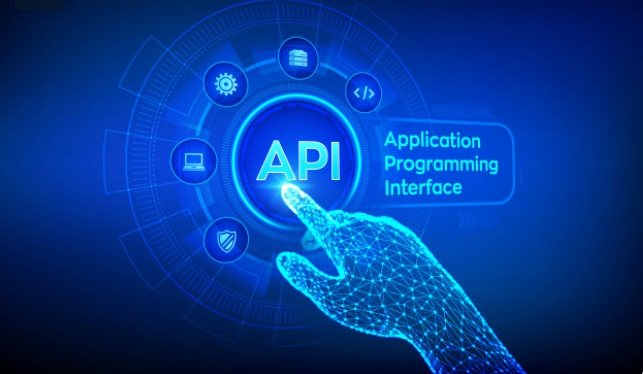Streamlining Business Processes with API Integration
API Integration
Introduction to API Integration:
Enhancing Efficiency and Connectivity API integration plays a pivotal role in enhancing efficiency and connectivity in today’s interconnected. digital world. An Application Programming Interface (API) acts as a bridge between different software applications, allowing them to communicate, exchange data, and perform actions seamlessly. By integrating APIs into various systems and applications, businesses can streamline their processes, automate tasks, and create robust connections with external platforms. API integration enables organizations to leverage the functionality and data of third–party services, applications, or systems without having to build everything from scratch. It fosters interoperability, allowing different software components to work together and share information effectively. This seamless integration reduces duplication of effort, eliminates manual data entry, and minimizes the risk of errors. By integrating APIs, businesses can achieve significant benefits.
Here are a few key advantages:
-
Enhanced Efficiency:
API integration automates data exchange and eliminates the need for manual intervention. It enables real–time synchronization of information across systems, ensuring data consistency and accuracy. By automating repetitive tasks, businesses can save time and resources, allowing their workforce to focus on more strategic activities.
-
Expanded Functionality:
APIs provide access to a vast array of functionalities offered by third–party services or systems. By integrating these APIs, businesses can extend the capabilities of their applications without reinventing the wheel. For example, integrating a payment gateway API allows businesses to process online transactions securely, enabling them to offer convenient payment options to customers.
-
Improved Connectivity:
APIs facilitate seamless connectivity between disparate systems and platforms. They enable data sharing, collaboration, and integration with external partners, suppliers, or customers. By integrating APIs, businesses can establish robust connections with other software applications, cloud services, social media platforms, IoT devices, and more, fostering a connected ecosystem.
-
Agility and Scalability:
API integration provides flexibility and scalability to adapt to changing business needs. By integrating APIs, organizations can easily add or remove functionalities, services, or systems as required. This adaptability enables businesses to respond quickly to market dynamics, customer demands, and technological advancements.
-
Innovation and Collaboration:
APIs foster innovation by enabling businesses to leverage external resources and services. They allow organizations to tap into the expertise and capabilities of third–party developers and integrate their solutions into existing systems. This promotes collaboration and the creation of new and unique offerings. However, API integration also presents challenges that need to be addressed. These challenges include ensuring data security, maintaining compatibility between systems, handling versioning and updates, and managing the complexity of multiple integrations.
Understanding the Role of APIs in Streamlining Business Operations
APIs (Application Programming Interfaces) play a crucial role in streamlining business operations by enabling efficient communication and data exchange between various software applications and systems. Here’s a closer look at how APIs contribute to the streamlining of business operations:
-
Seamless Data Integration:
APIs facilitate the smooth integration of data across different applications, platforms, and databases. By defining clear interfaces and data structures, APIs enable systems to exchange information in a standardized and reliable manner. This eliminates the need for manual data entry or repetitive tasks, reducing errors and saving time.
-
Process Automation:
APIs allow businesses to automate processes by connecting different software components and triggering actions based on predefined conditions. For example, an e–commerce platform can integrate with a shipping service API to automatically generate shipping labels and track packages, eliminating manual intervention and speeding up order fulfillment.
-
Efficient Collaboration:
APIs enable effective collaboration by enabling different teams or external stakeholders to access and share data seamlessly. For instance, integrating project management software with communication tools through APIs allows team members to receive real–time updates, exchange messages, and share files within a unified platform. This streamlines communication and improves productivity.
-
Integration of Third–Party Services:
APIs provide businesses with the ability to integrate third-party services, extending the functionalities of their own applications. This allows organizations to leverage specialized services such as payment gateways, mapping services, customer support systems, and more, without the need to build these functionalities from scratch. Such integrations enhance the user experience and provide additional value to customers.
-
Streamlined Workflows:
APIs help optimize workflows by integrating different software tools and systems involved in a particular business process. This integration eliminates manual handoffs and reduces the need for switching between multiple applications, streamlining the workflow and improving efficiency. For example, an API integration between a CRM system and an email marketing platform enables seamless synchronization of customer data and automates email campaigns.
-
Real–Time Access to Data:
APIs enable businesses to access real–time data from various sources. This allows organizations to make informed decisions based on up–to–date information. For instance, integrating APIs from social media platforms can provide real–time analytics and insights, enabling businesses to monitor their online presence, engage with customers, and adjust marketing strategies promptly.
-
Scalability and Flexibility:
APIs offer scalability and flexibility by allowing businesses to easily add or remove functionalities as needed. Instead of developing all features in–house, organizations can integrate APIs that offer specific capabilities or services, saving time and resources. This scalability enables businesses to adapt to changing market demands and expand their offerings rapidly.
Choosing the Right APIs for Integration Considerations and Selection Criteria
When choosing APIs for integration into your systems or applications, it’s essential to consider several factors and selection criteria to ensure a successful integration. Here are some key considerations to keep in mind:
-
Functionality and Suitability:
Evaluate the functionality offered by the API and determine if it aligns with your integration goals. Assess whether the API provides the specific features, data, or services that you require. Consider the compatibility of the API with your existing systems and ensure that it meets your business needs.
-
Reliability and Stability:
Examine the reliability and stability of the API provider. Research the reputation of the company or service offering the API, check for their track record, and assess their uptime and performance history. An API with a solid and stable infrastructure ensures consistent access to data and minimizes disruptions to your operations.
-
Documentation and Support:
Review the API documentation and available resources. Good API documentation should be comprehensive, and clear, and provide examples and code snippets to facilitate integration. Additionally, consider the support options provided by the API provider, such as developer forums, support tickets, or dedicated support teams. Access to reliable support can be crucial during the integration process and in resolving any potential issues that may arise.
-
Security and Privacy:
Data security is paramount when integrating APIs. Evaluate the security measures implemented by the API provider, such as encryption, authentication methods, access controls, and compliance with relevant data protection regulations. Ensure that the API follows best practices for safeguarding data and provides mechanisms for secure data transmission and storage.
-
Scalability and Performance:
Assess the scalability and performance capabilities of the API. Consider factors such as the API’s response time, throughput, and ability to handle increasing data volumes or user traffic. Scalability is particularly important if you anticipate future growth or spikes in usage that could strain the API’s capabilities.
-
Developer Experience and Community:
Consider the developer experience offered by the API. A well–designed API with intuitive documentation, code samples, and SDKs can significantly simplify integration efforts. Additionally, examine the size and activity level of the developer community surrounding the API. Active communities often provide valuable resources, insights, and community–driven support that can aid in integration and troubleshooting.
-
Cost and Pricing Structure:
Evaluate the cost and pricing structure associated with the API. Determine if the pricing model aligns with your budget and business requirements. Some APIs may have usage–based pricing, tiered plans, or additional costs for premium features. Consider the long–term costs of integrating and maintaining the API within your budgetary constraints.
- Integration Complexity and Effort: Assess the complexity and effort required for integrating the API into your existing systems or applications. Consider factors such as the API’s documentation quality, available SDKs or libraries, and compatibility with your development environment or programming languages. Choose APIs that provide well–defined and straightforward integration processes to minimize development and implementation time.
-
Vendor Viability and Longevity:
Consider the vendor’s viability and long–term commitment to maintaining and supporting the API. Evaluate their financial stability, roadmap, and future plans. It’s crucial to select APIs from reputable and established providers to ensure ongoing support and the availability of updates or new features.
By considering these factors and selection criteria, you can make informed decisions when choosing APIs for integration. Thorough evaluation and careful selection will contribute to a successful integration process and maximize the benefits derived from API integration in your business operations.
Implementing API Integration: Best Practices and Key Steps
Implementing API integration requires careful planning and execution to ensure a smooth and successful integration process. Here are some best practices and key steps to follow:
-
Define Integration Goals:
Clearly define your integration goals and objectives. Identify the specific functionalities, data, or services you want to integrate through APIs. Establish a clear understanding of what you aim to achieve with the integration to guide your implementation process.
-
Research and Select Suitable APIs:
Conduct thorough research to identify APIs that align with your integration goals. Evaluate the APIs based on the considerations mentioned earlier, such as functionality, reliability, documentation, security, and scalability. Choose APIs that best fit your requirements and provide the necessary features and capabilities.
-
Understand API Documentation:
Familiarize yourself with the API documentation provided by the API provider. Understand the API endpoints, data structures, authentication methods, request and response formats, and any limitations or rate limits. The documentation will guide you through the integration process and help you understand how to interact with the API effectively.
-
Plan Integration Workflow:
Plan the workflow for integrating the API into your systems or applications. Identify the specific steps involved, including authentication, data retrieval or submission, error handling, and any necessary transformations or mappings. Break down the integration process into smaller tasks to manage the implementation more efficiently.
-
Develop Integration Code:
Develop the code required to integrate the API into your systems. Depending on your programming language and development environment, use the appropriate tools, SDKs, or libraries provided by the API provider. Follow best practices for coding, such as modularization, error handling, and proper documentation within your codebase. Implement Authentication and Security: Implement the necessary authentication mechanisms to securely access the API. Follow the authentication methods recommended by the API provider, such as API keys, OAuth, or token–based authentication. Ensure that sensitive data is transmitted securely and that you adhere to the security practices outlined in the API documentation.
-
Handle Errors and Exceptions:
Implement error handling mechanisms to handle exceptions and error responses from the API. Account for potential failures or timeouts and define appropriate error-handling strategies, such as retries, fallback mechanisms, or logging for troubleshooting purposes. Thoroughly test your error-handling logic to ensure it works as expected.
-
Test and Validate Integration:
Test the integration thoroughly to validate its functionality, performance, and compatibility. Conduct both positive and negative test cases to ensure that the integration works as intended in different scenarios. Validate data accuracy, error handling, and system behavior during high loads or concurrency. Use testing environments or sandbox environments provided by the API provider if available.
-
Monitor and Maintain the Integration:
Implement monitoring mechanisms to track the performance and availability of the integrated APIs. Monitor response times, error rates, and other relevant metrics to identify potential issues or bottlenecks. Stay up to date with API updates, version changes, or deprecations communicated by the API provider. Maintain the integration by periodically reviewing and optimizing the codebase and addressing any necessary updates or improvements.
-
Document and Document:
Document the integration process, including key steps, configurations, dependencies, and any specific implementation details. Maintain clear and updated documentation to aid future maintenance, troubleshooting, or further enhancements. Document any limitations, workarounds, or tips that might be useful for other developers working with the integration.
By following these best practices and key steps, you can implement API integration effectively and ensure a successful integration process. Thorough planning, careful development, and diligent testing will contribute to a robust and efficient integration that enhances your business operations.
Overcoming Common Challenges in API Integration and Solutions
The API integration can present various challenges during the implementation process. Here are some common challenges and their potential solutions to help you overcome them:
-
Authentication and Authorization:
Integrating APIs often requires implementing authentication and authorization mechanisms. The challenge lies in managing and securely storing credentials, tokens, or API keys. Solutions include using secure storage methods, such as encrypted key vaults, or implementing OAuth or token–based authentication to ensure secure access to APIs.
-
Data Mapping and Transformation:
APIs may have different data formats or structures than your existing systems. Data mapping and transformation challenges arise when reconciling these differences. Use data mapping tools or libraries that can handle transformations between different formats or build custom logic to map and transform data accurately during the integration process.
-
Error Handling and Resilience:
APIs can encounter errors or experience downtime, impacting your integration. Implement robust error handling mechanisms, including retries with exponential backoff, fallback mechanisms, and proper logging to capture and address errors effectively. Ensure that error responses from the API are appropriately handled and communicated to users or relevant stakeholders.
-
Rate Limiting and Throttling:
APIs often impose rate limits or throttling to control the number of requests made. This can pose challenges if your integration requires frequent or high–volume data exchanges. Stay within the specified limits by monitoring usage and implementing strategies such as batching requests, caching data, or negotiating with the API provider for higher limits when necessary.
-
Versioning and Compatibility:
APIs may undergo updates or version changes that can affect your integration. Stay informed about API versioning and changes communicated by the provider. Implement proper version management practices to handle compatibility issues and consider building flexible integrations that can adapt to future API updates.
-
Performance and Scalability:
As your integration scales or experiences high traffic, performance and scalability challenges may arise. Monitor the performance of the integration and optimize where necessary. Implement caching mechanisms, optimize data retrieval or processing, and consider horizontal scaling or load balancing to ensure your integration can handle increasing demands.
-
Documentation and Support:
Inadequate or outdated documentation, or lack of proper support from the API provider, can hinder the integration process. Engage with the API provider’s support channels, developer forums, or community resources for assistance. Provide feedback to the API provider regarding any documentation gaps or issues to improve the integration experience for yourself and other developers.
-
Security and Compliance:
Data security and compliance are critical aspects of API integration. Ensure that the API provider follows industry–standard security practices and adheres to relevant regulations. Implement encryption, secure transmission protocols (e.g., HTTPS), and proper access controls to protect sensitive data exchanged through the API.
-
Testing and Debugging:
Thoroughly testing the integration and debugging potential issues can be challenging. Develop a comprehensive test plan, including positive and negative test cases, to cover various scenarios. Use testing environments or sandbox environments provided by the API provider to simulate real–world conditions. Leverage debugging tools, logging mechanisms, and error monitoring to identify and resolve issues effectively.
-
Maintaining Compatibility:
As your systems or the integrated APIs evolve over time, maintaining compatibility becomes crucial. Regularly review and update your integration to accommodate changes in the APIs or your systems. Stay informed about deprecations or upcoming changes communicated by the API provider and plan accordingly to ensure continuous compatibility.
By addressing these common challenges with appropriate solutions and proactive measures, you can overcome obstacles in API integration and ensure a robust, reliable, and successful integration process.


